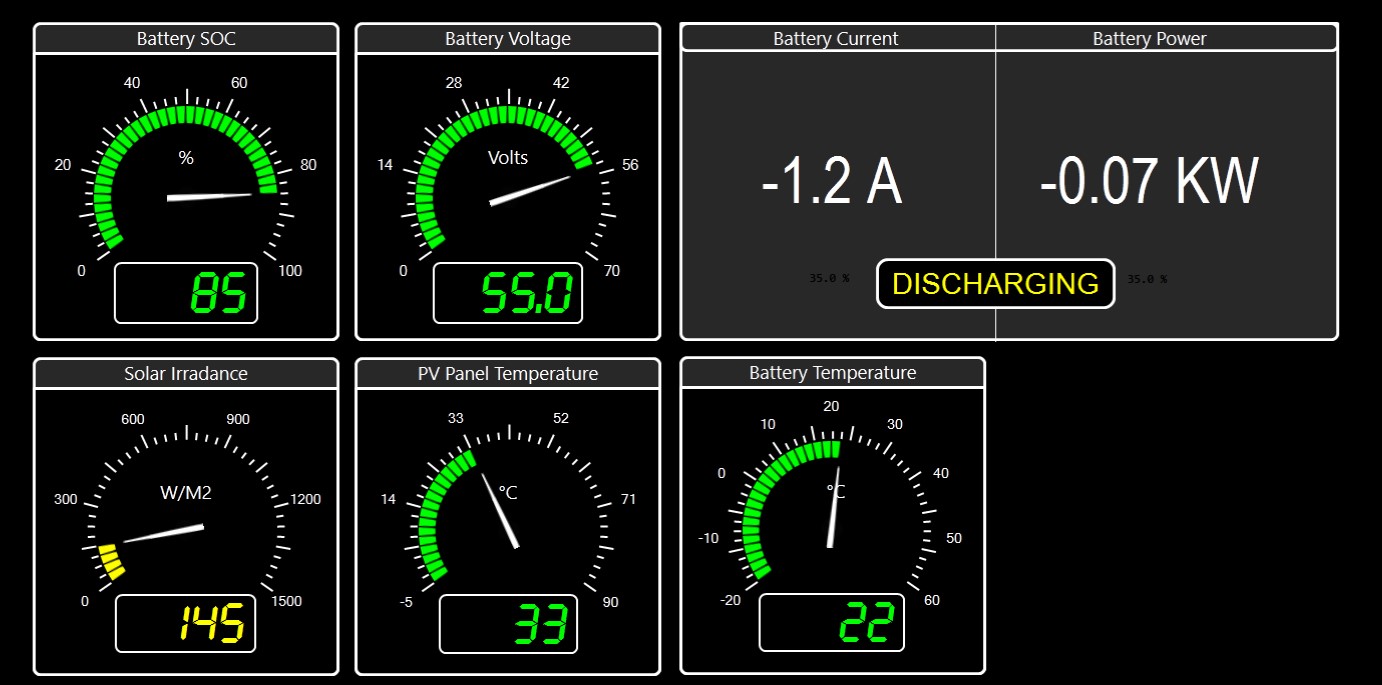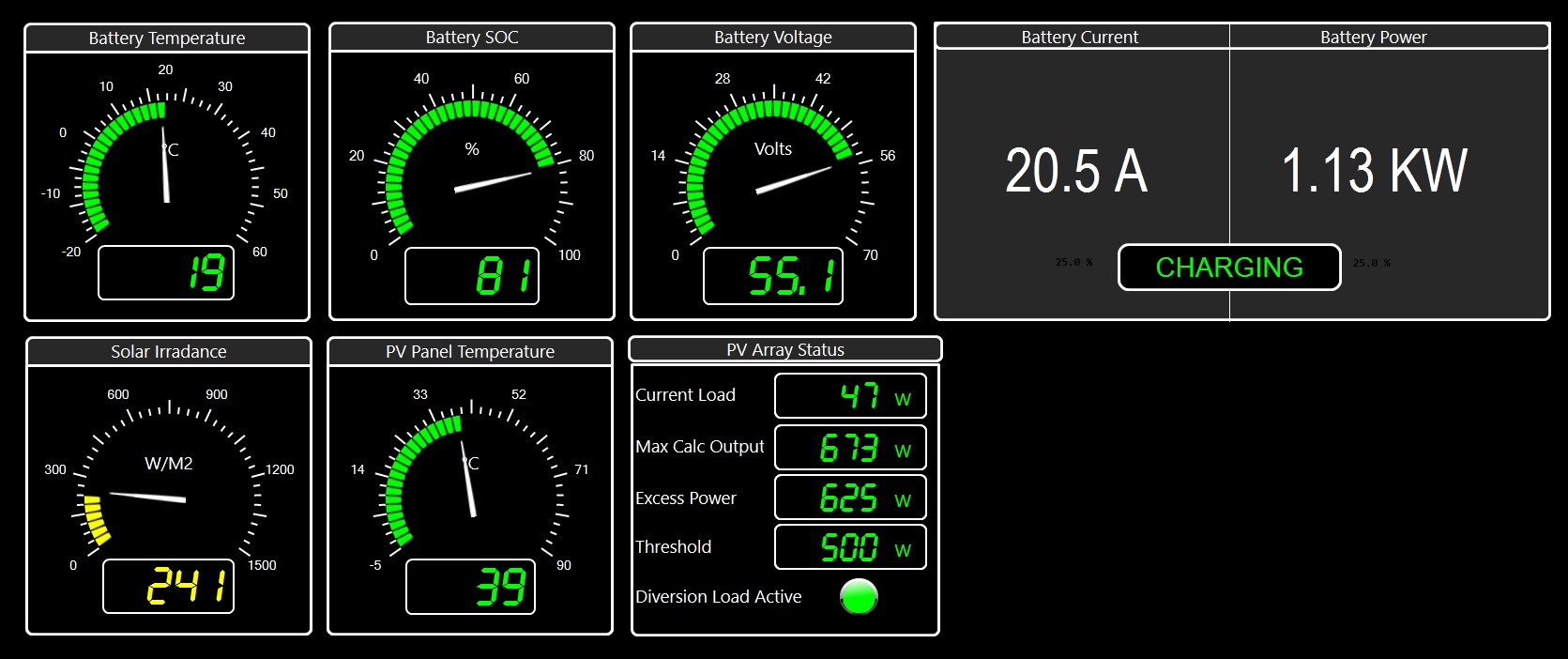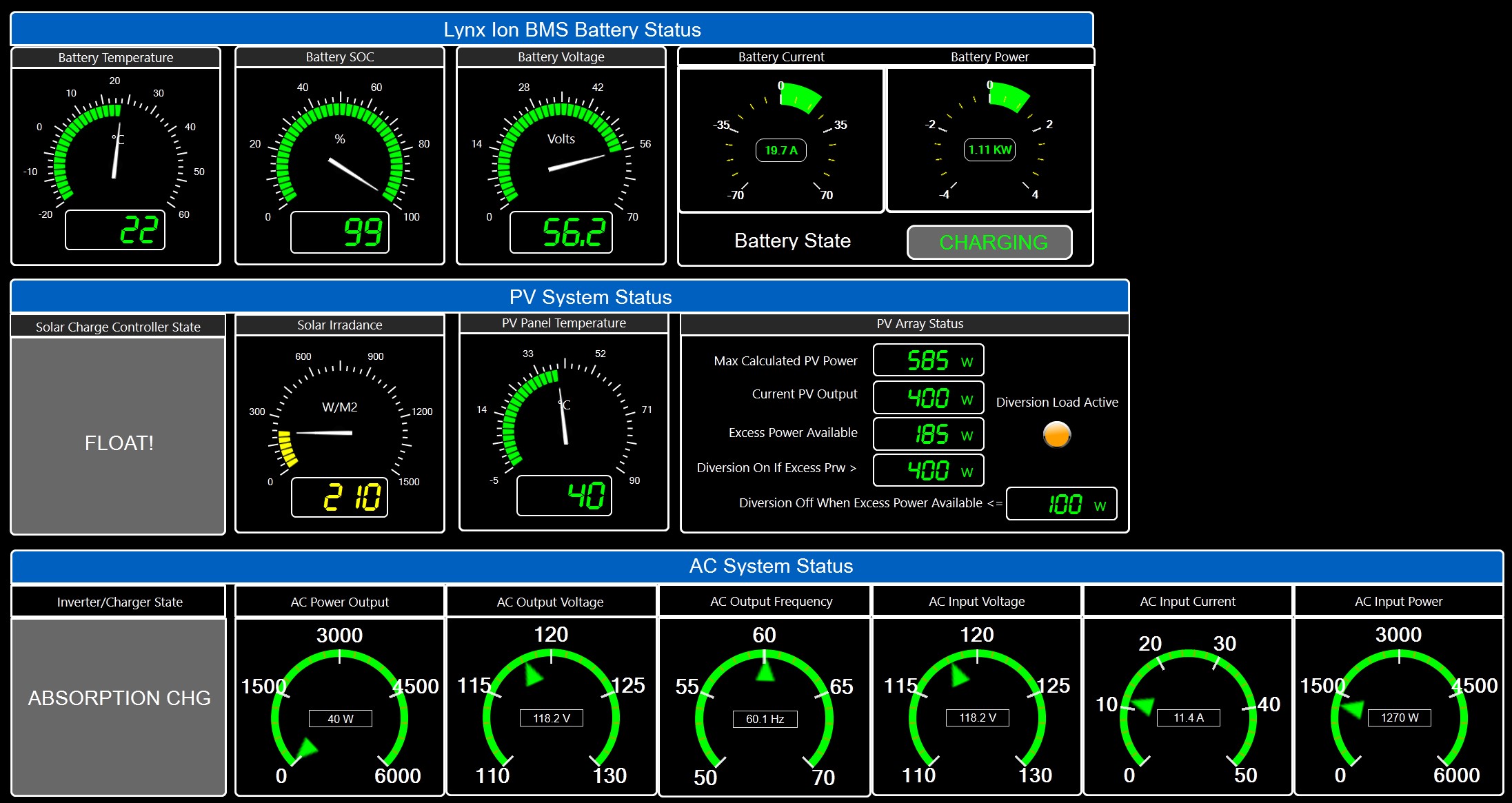As discussed in the below post I am working on a project to measure excess, available PV power and use that power to automatically control a load.
https://community.victronenergy.com/questions/6806/can-the-ccgx-activate-relay-for-hot-water-heater-w.html
I now have a working prototype using a PLC, with a Ladder program, that performs this function. The key is installing an Irradiance/Temperature Sensor at the PV array. The one I used is an Si-I-420TC-T made by Mencke & Tegtmeyer GmbH. Link to the sensor is below:
https://www.imt-solar.com/products/solar-irradiance-sensor/si-sensor/
I am still working on the Project's documentation, so I am including a wiring diagram and an Excel spreadsheet which demonstrates the calculation to compute available excess power.
Look forward to the conversation,
Pat
BRX_Wiring_Diagram_Rev01.pdf
- Home
- Anonymous
- Sign in
- Create
- Spaces
- Grafana
- Node-Red
- Unsupported topics
- Questions & Answers
- Modifications
- Communauté francophone
- Deutschsprachiger Bereich
- Preguntas en Español
- Explore
- Topics
- Questions
- Ideas
- Articles
- Badges
question
Calculating and Controlling Excess PV Power
Hi Pat,
I am very much interested in the idea of determining if excess power is available from the PVs.
In my case I have 4 Victron MPPTs charging 3 Pylontech batteries. I have a Venus controller and two Victron inverters in parallel. All is working well. However, I do want to make sure I am using every bit of energy from the solar panels possible - good resource utilisation.
My first attempt was to determine the theoretical energy limit that I should be getting based on the time of day and the installation angle of the panels, compared to average irradiance per year month to month.... data available here http://solarelectricityhandbook.com/solar-irradiance.html.
My plan now is rather to monitor the MPPTs to determine when they are 'throttled back' due to under loading from either the battery charging or other loading. Appliance control is via MQTT, node-red and something similar to sonoff.
..this, of course, in between all the other home automation projects...
Regards,
Nico
Nico,
There a lot of ways to skin a cat. (Pardon the American anachronism). Your idea may work fine for you. What I am working on actually measures the Solar Irradiance at the panel array, so there is no guess work, and the math is a lot simpler.
Pat
I'm glad there are smarter individuals than me on here. I had a similar thought as only have a small 60 amp/h battery and 500w panels. I would love to use the excess to heat a water tank and my 12v underfloor heating.
All in my van!.
Good luck and share
Hi Pat,
Correct, there are a lot of ways to achieve this goal. However the goal of this conversation is to generate new thoughts....and open up new ideas.
The solution I am looking for makes use of the existing hardware that is already installed to keep costs down - the irradiance sensor you are using is after all a miniature PV panel, and I already have a view bigger ones on the roof. Yes they might not be calibrated but they can be used to measure relative irradiance changes.
The challenge for me is to find the right thing to measure on the MPPTs to know when they are being "throttled" due to under loading....
The interesting next thing then would be how to select the appropriate load to take up the shortfall when available. My first choice would be the electric hot water system and for that to be effective I need to do some PWM of the power to the element to have a much more variable load.
Then also the historic average irradiance data would be useful in trying to guess how much PV energy is left for the day to better select the target for that energy.
Regards,
Nico
Nico,
Sorry to take so long getting back to you, got pulled off on another project.
I thought long and hard about how to calculate the excess power available from existing data. Maybe it's my engineering background, but I always came back to the question; "How do I really know?". I originally thought about how to initiate a full load condition on the PV array and measure that, but the solution involved some very complex hardware. I also thought about using historical data but wanted a solution that was real time. That's when I went with the Solar Irradiance/Temperature sensor.
The sensor also comes in a MODBUS output version and Victron could program the Venus OS to read that data, make the Excess Power calculation, and activate a relay. That way, other than the sensor, no other hardware would be required.
Lots of alternatives and lots of choices. I hope others will get involved in the discussion.
Thanks,
Pat
One option to "measure solar" from the MPPT is to count pulses, from the VE-direct port, and the Venus GX has digital inputs, which can be used to do that. Would require some mods, however, to the OS or something, because the units assigned in the Venus menu are not approprate (m3, L etc). You can access the pulse output via an option in victron MPPT, while tapping into the TX pin of the VE.direct port, I think. (I toyed with the idea of doing that, I think it can be setup to access that pin, as well as have a VE.direct cable attached to a Venus device...shared.)
As to how the pulse count idea would work practically, I am not sure...is some technical questions...for example I can't quite recall whether the pulses are actual solar level or throttled solar level. But...in principle could work.
Sounds interesting. Don't know about the pulse count being actual or throttled. Suspect it is throttled. If it was actual, surely someone would have thought of that before.
But you never know.
Pat
Still working on the documentation. However, I have the system built. Can measure the solar irradiance and panel temperature and use that to trigger a load when I have enough excess solar power to keep from draining the battery. Below is dashboard showing some of the measurements, all are from the CCGX except for the Solar Irradiance and Panel Temperature, which come from a separate PLC. More to come.
Pat

Attached is an image of the nearly complete monitoring panel. Hopefully will have the full specification document ready this week.
Pat

Still working on the Specifications, I hate writing technical papers. Continuing to test and have updated the HMI Dashboard and wiring diagram. They are attached. I wonder if Victron can figure out a way to read two, scaled 4-20mA analog sensor inputs into the Venus GX or Octo? I could do away with all the extra equipment and use the Modbus TCP HMI to do the calculations.
Pat

The simplest solution to this would be for the controllers to continually publish the “duty cycle” value when the controller moves from bulk (MPPT) to absorb or float. This “duty cycle” value is a percentage of available energy that is being allowed to flow to the load/battery. The remainder is excess energy.
While this value would not be 100% accurate (due to the differences between MPPT and PWM), it would be a very good approximation of the available energy.
Best of all, it would require no additional hardware and just be a small software change for the developers.
I am working with an off grid system so retention of battery power is very important. I have a large enough array that, even if the batteries are charging in Bulk mode, I may have enough excess power available to run a diversion load. I all depends on the Solar Irradiance hitting the panels. That's why I went a Solar Irradiance sensor and all the associated hardware. I am not saying this is a practical solution, but it works for me. There are other alternatives, especially with Grid Tied or Grid Assist systems, that work as well.
Thanks for the input, That's why I started this thread. Could you please publish the formula you would use to calculate the "Duty Cycle Value".
Thanks,
Pat
My system is also off-grid and I have a relatively large array (in relation to the battery bank).
Nobody but Victron knows how their controllers really operate, but how I think they operate is that when in BULK mode and not exceeding their rating (ie trying to harvest the maximum solar energy) they operate in MPPT mode. At all other times, they operate in PWM mode (PWM = Pulse Width Modulation). In PWM mode they will be continuously calculating a value called the duty cycle - this is the percentage of the time that the internal MOSFETs (electronic switches) are on. This duty cycle value, if published externally by Victron (by VE.Direct to the Venus device - that could then publish via MQTT) would make a very good starting point for calculating the amount of excess solar that could be used in a load dump.
I do have a system setup now that dumps excess solar into a water heater, but because I don't have access to the duty cycle, I must use other less accurate means of estimating.
Why would you publish this only when the MPPT controller moves between modes- why not 'always'?
The next question is how this value can be 'published' in such a way that it can be used to accomplish something, like switching on a load. Such as within a Virtual Switch or an Assistant?
Having a on Grid system with ESS my required solution may be different, but anyway an interesting thread.
After browsing the docs and this forum for a while I’m still a bit puzzled about the fact that Victron doesn’t provide an easy way to manage opportunity loads. In my humble opinion individual load management is a crucial need for most self consumption on- or off grid installations similar as the sophisticated charger and inverter control system ESS does provide quite well.
I did create some specs about a possible load management solution that should fit for most of the use cases. But this should ev. placed better on a separate thread.
Victron_LMS_Specifications_v1.pdf
For all of you. I developed a system a few years ago to use the energy excess. The system has been tested with really nice results with AC-Coupled Victron Fronius, 3kVA, 4,5 KWp, 24V-445Ah flooded batteries.
This system calculates in a simple and really cheap way the PV available power and calculate the excess when the Fronius intruder is throttled.
With that system, I'm running two AC, a water treatment plant a a water heater. The system can handle up to 6 loads and also has its own App to monitor, set parameters and switch on/off the different loads.
Related Resources
Additional resources still need to be added for this topic
question details
26 People are following this question.
